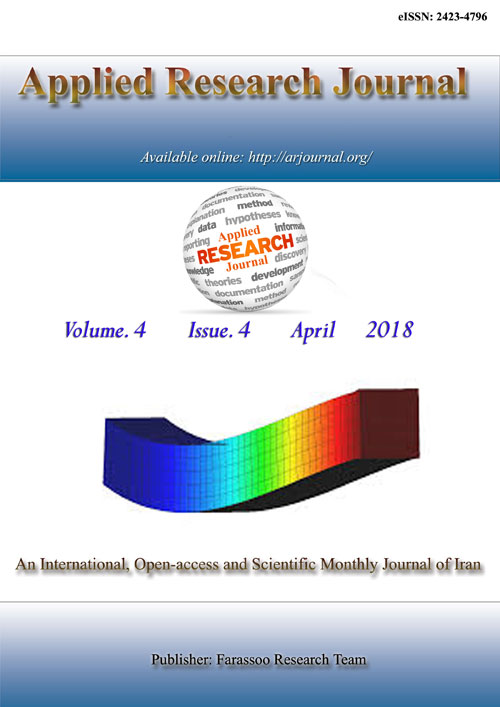فهرست مطالب
Applied Research Journal
Volume:2 Issue: 10, Oct 2016
- تاریخ انتشار: 1395/08/08
- تعداد عناوین: 4
-
Determination of the geoid height (geoid undulation) by using modern surveying technologiesPages 403-411In this work, a large part of Baghdad University campus has been selected. The determination of Geoidal height for the local area requires Ground Control Points which both Ellipsoidal and Orthometric heights are known to compute the difference between them. The first step of the leveling process began by selected the Ground Control Points (GCPs) around the area of the work, and then divided them into two groups of the network traverse stations. They were leveled and adjusted depend on the number of the Bench Marks (B.M.s). Total Station TS (Nikon Nivo 5C) and Global Positioning System (GPS-Garmin 78 map) are used to do this application. The aim of the proposed work was to determine the height of the Geoid surface in the study area. The Geoidal height is calculated from the difference between the two different heights (Orthometric and Ellipsoidal) for the same point and using Geoid Model (EGM) method, then to compare between them. Maximum and the minimum values for the Geoid Undulation are (1.6261 m), and (1.5964 m) respectively with average (1.61 meter) by using (EGM 2008). When it is used the difference method (h-H), maximum and the minimum values for the Geoid Undulation are (5 m), and (2 m) respectively. Finally, the model EGM-2008 represents the best method to determine the Geoid Undulation. dN value between the two different methods is a maximum (3.40) m, a minimum (0.40 m), the average value (1.5 m), and a standard deviation (SD)= ±0.030. At last, image map was produced using Arc GIS 10.1.Keywords: Geoidal Height, GCPs, Geoid Model, Orthometric, Ellipsoidal, Total Station
-
Effect of grout depth variation on the bearing capacity of the Iraqi sandy soilPages 412-420In the present work, improving the behavior of a strip footing rested on the sandy soil before and after the permeation grout by cement was studied and also how the variation grout depth hole with the water - cement ratio effect on the soil bearing capacity. So, improving the shear strength of the sandy soil also studied by injected (1) cm³ of slurry in the center of the direct shear box. Sandy soil was improved by using cement grout with three weight percentages of water cement ratio (w:c); (0.9w:0.1c, 0.8w:0.2c, and 0.7w:0.3c), while the sand was obtained from Karbala city and it will be classified as poorly graded sand (SP) according to USCS. To know the value of the bearing capacity of grouted soil with the selection pattern of grout hole , the static load settlement tests were done, while three grout hole depth was used (0.5B,B,2B) for all (w:c). For all tests, the soil samples were dehydrated for one day curing time. According to the results of tests, the shear strength of the treated soil with cement grout was increased when the water cement ratio decreased, and when the grout hole depth was decreased and the water cement ratio increased, the value of the bearing capacity will be increased as a result sedimentation.Keywords: Soil Improvement, Grouting With Cement, Strip Footing, Grout Hole Depth
-
An investigation to joining characterizations of three-layered sheet of brass/steel/brass made by cold roll-claddingPages 421-426The cold welding by using of rolling is a process in which two different metals may joint to each other. In this study at the first, the steel and brass plates were prepared by oil cleanup and brushing processes. At the second, by putting the steel plate between brass plates and then rolling, three-ply composite brass/steel/brass with different thicknesses was produced. To examine the initial roughness and bonding strength of the three-ply composite, samples were evaluated by topographic study and pilling test according to ASTM-D1876. Also, to analyze the effect of layer preparing method on cold welding quality, microscopic investigations were performed using SEM. The results showed that by increasing the initial roughness of sheets, the joining strength were increased as a result of the possibility of more extrusion of brass in the steel base and The results showed that the R45 was lower than R0, Also the R enhanced by increasing the annealing temperature.Keywords: Roughness, three, ply composite, bonding mechanism, cold welding, R, Value
-
Experimental study of heat transfer enhancement of cu-water Nanofluid in a hele-shaw cellPages 427-432The aim of study was to evaluate the effect of Cu-water nanofluids with different volume fraction of heat transfer in a Hele-Shaw cell. For this purpose a Hele-Shaw cell made of plexiglass screen (transparent) and within the chamber by the base fluid (water) and nanofluids (Cu-water) is filled. Hele -Shaw cell study heat transfer in many industrial applications including electronics and industrial cooling can be named. Increasing the volume fraction of nanoparticles increase the thermal conductivity of nanofluids increasing the amount of heat transfer. It is worth noting that the dramatic rise in energy costs is very useful in various industries. With increasing concentrations of nanoparticles, nanoparticle interactions and collisions between more and the difference in temperature between the wall and the fluid will fall further and further improvement in heat transfer coefficient is observed. The largest increases were nanofluids heat transfer coefficient for Cu-water nanofluids 0.04 per cent by volume showed that more than 32%.Keywords: Heat transfer, Cu, water nanofluids, volume fraction, Hele, Shaw cell


